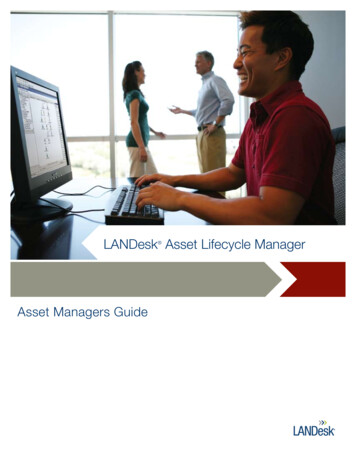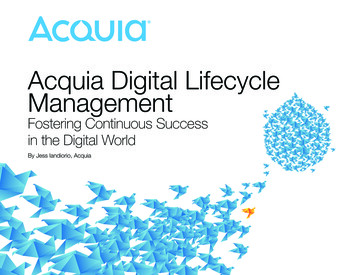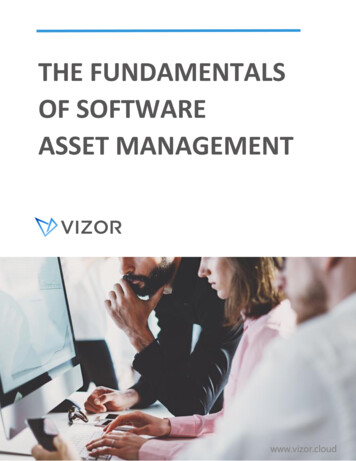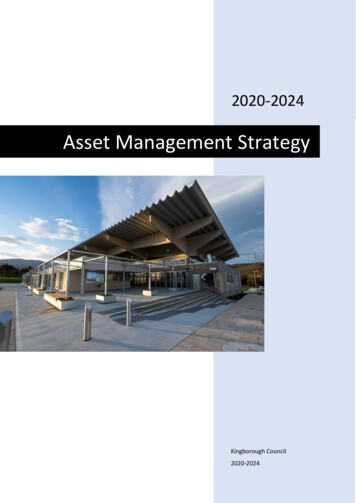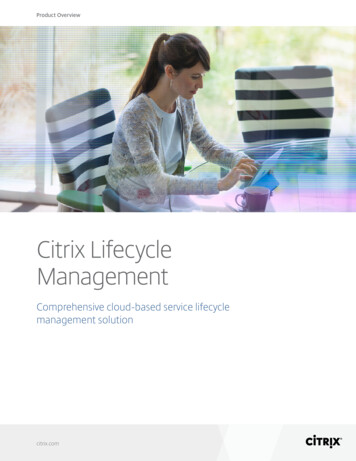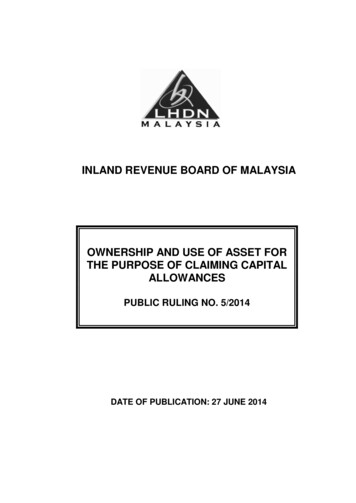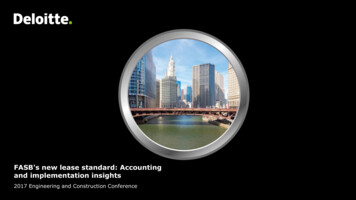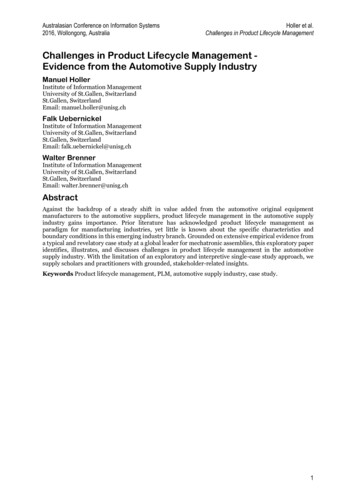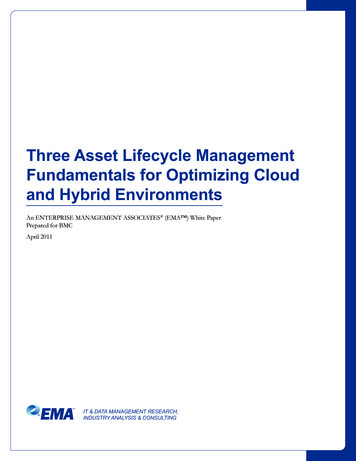
Transcription
Three Asset Lifecycle ManagementFundamentals for Optimizing Cloudand Hybrid EnvironmentsAn ENTERPRISE MANAGEMENT ASSOCIATES (EMA ) White PaperPrepared for BMCApril 2011IT & DATA MANAGEMENT RESEARCH,INDUSTRY ANALYSIS & CONSULTING
Three Asset Lifecycle Management Fundamentalsfor Optimizing Cloud and Hybrid EnvironmentsTable of ContentsIntroduction.1The Rise of Service-centric Asset Management and Why It’s Relevant to Cloud.2Cloud Computing as Catalyst and Transformer.3Discovery – Understanding Your Assets and Their Interdependencies.4Modeling Assets to Support Real-Time Actions and Long-Term Strategic Planning.5Unique Requirements for Service Portfolio Planning.6Automation – Optimizing Asset Investments in Real-Timefor Cloud.7Summary and Conclusion.7About BMC.8 2011 Enterprise Management Associates, Inc. All Rights Reserved. www.enterprisemanagement.com
Three Asset Lifecycle Management Fundamentalsfor Optimizing Cloud and Hybrid EnvironmentsIntroductionThe ENTERPRISE MANAGEMENT ASSOCIATES (EMA ) concept of “Service-centric AssetManagement” has its own roots, but shares a largely common vision with ITIL v3’s concepts of “ServiceLifecycle Management” and “Asset Lifecycle Management.” The telecommunications industry andbest practices such as the Telecommunication Management Forum’s eTOM guidelines also supportthis idea. Collectively, these approaches underscore the logicallyobvious assumption that if a technology organization’s “products”are its “services,” then all assets (capex and opex) should ideallyIf a technology organization’sbe planned and optimized as performing entities to support the“products” are its “services,”delivery of superior services.then all assets (capex andopex) should ideally be plannedand optimized to support thedelivery of superior services.However, IT organizations have historically been staffed, managedand run on what EMA calls an “academic model.” This model isdefined by skill groups that tend to work in siloed isolation of eachother, and are often protective of “turf ” much in the way academicdepartments fight for support across a common university budget.This is a territorial model for cost allocation in which IT as a whole becomes a “territory to bedefended.” The result is a fragmented, incomplete and often conflicted approach to managing andoptimizing IT and IT-related assets in support of service delivery.This is gradually changing for many reasons. One of these is the growth of ITIL and best practices, andthe shifting role of IT as its services become more business transformative through new applicationtechnologies such as Web 2.0. An outgrowth of this and other technologies has been the rise of IT/business ecosystems in which partners, service providers and sometimes supply chains interact in anumbrella of IT/business services that are radically altering not only e-business, but virtually all verticalsfrom Financial Services, to Healthcare, to Manufacturing, to public sector organizations.But the single most visible accelerant for this process today is Cloud computing services. These areputting pressures on IT to optimize their capex and opex investments more dynamically in supportof new service delivery models. This includes critical requirements to account more effectively forasset costs and asset values in context with capacity optimization and service lifecycle management.Cloud computing and the various virtualization and other technologies that support it requirea more dynamic, more automated, and fundamentally more cross-domain approach to managingand optimizing assets –including service provider resources – as a cohesive extension of IT serviceplanning and service delivery.Page 1 2011 Enterprise Management Associates, Inc. All Rights Reserved. www.enterprisemanagement.comPage 1
Three Asset Lifecycle Management Fundamentalsfor Optimizing Cloud and Hybrid EnvironmentsThe Rise of Service-centric Asset Management and Why It’sRelevant to CloudThe good news is that IT organizations have been slowly evolving towards a more service-centricmodel for optimizing assets for at least five years. For instance, in the EMA report Service-Centric AssetManagement in the Age of Cloud Computing, February 2011, data showed that 39% are managing servicesand assets together, a modest increase of 5% over 2009 (Figure 1).How would you characterize your company’s existing environment?Asset management and service planning aremanaged together39%Asset management and service planning aremanaged separately34%Asset management and service planning aremanaged separately today but will be managedtogether in the future28%0%5%10% 15% 20% 25% 30% 35% 40% 45%Column %Figure 1: EMA research data shows a modest growth in IT organizations managingat least some portion of their assets and services together.This data shouldn’t be construed as indicating that 39% of respondents have overarching processesand technologies for integrating all aspects of service and asset planning across all domains, but thatat least a meaningful stake has been put in the ground. Indeed, other data from the same researchindicates that only 33% have a single central organization for managing assets – which is not alwayscombined with service planning (e.g., when organizations such as “procurement” take the lead.)But there are other factors that show that combining asset management with service managementis a significant plus. For instance, when service and asset management are brought together, ITorganizations are more than twice as likely to leverage ITIL best practices. And perhaps even moresignificantly, this combination favors more effective IT performance overall. One indication of this isthat IT organizations with service-centric asset management are more than twice as likely to see their budgetsgrow as IT organizations with a more siloed approach to asset management!Page 2 2011 Enterprise Management Associates, Inc. All Rights Reserved. www.enterprisemanagement.comPage 2
Three Asset Lifecycle Management Fundamentalsfor Optimizing Cloud and Hybrid EnvironmentsCloud Computing as Catalyst and TransformerWhile Cloud computing is often misrepresented as an endgame in itself (e.g., “the journey to theCloud”), it does have a serious catalytic impact not only on technology adoption, it has also begun toaccelerate changes in the very role of IT and, as an extension of that – the role of asset lifecycle managementwithin IT. Cloud, across its various enabling technologies (Software-as-a-Service, Infrastructure-as-aService, and Platform-as-a-Service), and its mix of private, public and community environments, ismoving IT towards more a of a service broker model with linkagesvery much in keeping with ITIL v3’s concepts of integrated serviceand asset lifecycle management.Cloud is moving IT towards morea of a service broker modelwith linkages very much inkeeping with ITIL v3’s conceptsof integrated service andasset lifecycle management.In the EMA 2011 report, Service-Centric Asset Management in theAge of Cloud Computing, 86% of respondents indicated that Cloudcomputing was impacting their asset management strategies.Significantly, 89% view Cloud computing as making assetmanagement more cross-domain, and 70% see Cloud as movingtheir asset management towards a more service-centric model(Figure 2).Taken overall, Cloud computing and/or cloud services are making ourasset management strategies.19%stay the same.less service-centric.11%more n %Figure 2: 70% of respondents believe that Cloud computing is moving their IT asset management capabilitiestowards a more service-centric model, and 89% see Cloud as making asset management more cross-domain.Among some of the key areas where Cloud is impacting asset management, respondents indicated: Page 3Changes in how assets are measured for cost and valueChanges in organizational ownership in asset managementAdded requirements for real-time awareness of where assets are and how they’re performingAdded requirements to account more effectively for asset usage and impactAdded requirements for automation 2011 Enterprise Management Associates, Inc. All Rights Reserved. www.enterprisemanagement.comPage 3
Three Asset Lifecycle Management Fundamentalsfor Optimizing Cloud and Hybrid EnvironmentsDiscovery – Understanding Your Assets and TheirInterdependenciesDiscovery is a term that can mean many things – especially once asset and service management arebrought together. Traditional asset discovery systems focused on inventory and as they advanced, moreinsights into software and hardware configurations and software license management. As it continues toevolve towards a more service-centric model, IT asset management is beginning to leverage discoveryas a vehicle for capturing service interdependencies across entire application ecosystems.Capturing asset-to-service interdependencies isn’t just “bells-and-whistles.” Once IT makes thetransition from viewing its assets as more or less static commodities, to seeing them as performingentities in support of superior service delivery, understanding the context for where and how assets areused becomes even more important as managing them in isolation. This natively links asset management,capacity planning, service provisioning and even service performance.Needless to say, the need for automation in discovering assets isgrowing, especially with the increasingly dynamic nature of Cloudcomputing and its service delivery options. In the EMA 2011 report,however, only 58% of respondents had automated capabilities forasset discovery and inventory. But there is definitely a “we/them”group between those who manage services and assets together andthose who manage them separately as indicated in Figure 3. Thisdiscrepancy is yet one more testament to the value in integratingservice and asset lifecycle management.Needless to say, the needfor automation in discoveringassets is growing, especiallywith the increasingly dynamicnature of Cloud computing andits service delivery options.Does your company have automated asset discovery and inventory systems in place?By How would you characterize your company’s existing environment?Asset management andservice planning aremanaged separately33%Asset management andservice planning aremanaged together29%Asset management andservice planning aremanaged separately todaybut will be managedtogether in the future32%67%71%Yes68%NoFigure 3: Those managing services and assets together are much more likely toemploy automated capabilities for asset discovery and inventory.Page 4 2011 Enterprise Management Associates, Inc. All Rights Reserved. www.enterprisemanagement.comPage 4
Three Asset Lifecycle Management Fundamentalsfor Optimizing Cloud and Hybrid EnvironmentsModeling Assets to Support Real-Time Actions and LongTerm Strategic PlanningThere is a clear transition from discovery and inventory management to service modeling, as discoverybecomes more and more about configuration and interdependencies. Simply put, the importance ofmodeling is that it allows both physical and logical asset associations and dependencies to be capturedand reconciled as a consistent, contextual foundation for everything from real-time decision making,to long-term planning, to diagnostics and automation.An effective modeling system can potentially enable: More accurate and reconciled sources of information aboutassets Clear and consistent delineations of asset “owners,” and“consumers” Clear and consistent mapping to contractual, vendor and otherfinancially specific interdependencies Clear and consistent information about how, when and whereservice-related assets are usedModeling allows both physicaland logical asset associationsto be captured and reconciledas a consistent, contextualfoundation for everything fromreal-time decision making,to long-term planning, todiagnostics and automation. Change automation in support of asset lifecycle management Diagnostics in support of asset availability Service provisioning and request management Audits, governance and other related actions critical to asset lifecycle management Service portfolio planningThe EMA report, Service-Centric Asset Management in the Age of Cloud Computing, documents the factthat asset-related information is still spread out across the corporation in a variety of places fromspreadsheets and Visio drawings, to local databases, to separate asset information repositories, toCMDBs and federated Configuration Management Systems (CMSs). Not surprisingly, asset-relateddata accuracy was modest at best, with only 23% claiming more than 95% data accuracy for managingasset lifecycles, while more than 70% wished they had a more than 95% level of data accuracy.Cloud computing is, once again, accelerating the importance of modeling, as can be seen in the databelow. Both Service Catalog and CMDB investments show strong benefits in realizing values fromCloud adoptions. In EMA research from Operationalizing Cloud: The Move to a Cross-Domain ServiceManagement Strategy, February 2011:Those surveyed with CMDB/CMS investments are: 1.4 times more likely to reduce complexity of management via Cloud 1.4 times more likely to improve service resilience via Cloud 1.6 times more likely to accelerate deployment of existing services via Cloud 1.6 times more likely to accelerate the creation of new services via Cloud 1.5 times more likely to increase infrastructure flexibility via Cloud 1.7 times more likely to expand revenue channels via CloudPage 5 2011 Enterprise Management Associates, Inc. All Rights Reserved. www.enterprisemanagement.comPage 5
Three Asset Lifecycle Management Fundamentalsfor Optimizing Cloud and Hybrid EnvironmentsThose surveyed with Service Catalog investments are: 1.4 times more likely to reduce management complexity 1.4 times more likely to reduce capital costs via Cloud 1.5 times more likely to improve service resilience via Cloud 1.5 times more likely to accelerate deployment of existing services via Cloud 1.6 times more likely to accelerate creation of new services via Cloud 2.2 times more likely to expand revenue channels via CloudUnique Requirements for Service Portfolio PlanningDEMANDModeling between capabilities such as the CMDB/CMS and a service catalog or service portfolio arecentral to service portfolio planning. As IT organizations move to understand value and performanceas well as cost and compliance interdependencies, virtually everything in the list above for modelingbecomes relevant to effective service portfolio planning. Figure 4 provides a simplified but usefulway of grasping the interdependencies that ideally should be captured for service portfolio planningas IT moves more and more towards assuming its role as a fully integrated part of the business ororganization it serves.ServicesAssetsPeopleProcessCompliance NeedsTYIALUQCOSTFigure 4: Service Portfolio Planning requires a fully integrated awareness of thedynamics inherent in integrated service and asset lifecycle management.Page 6 2011 Enterprise Management Associates, Inc. All Rights Reserved. www.enterprisemanagement.comPage 6
Three Asset Lifecycle Management Fundamentalsfor Optimizing Cloud and Hybrid EnvironmentsAutomation – Optimizing Asset Investments in Real-Timefor CloudIt should come as no surprise that automation is a key aspect in optimizing assets for Cloud where ITasset management, capacity optimization, service performance and configuration management can becollapsed into single moments in time.But automation, itself, is multi-faceted. EMA typically divides it into: people-to-people (e.g., workflow),people-to-machine (e.g., configuration management, service request management), and machine-to-machine (e.g., workloadautomation). But it’s the emergence of IT Process Automation (ITPA) or run book automation that’sbecoming the glue to help set policies that can orchestrate automated processes across all these, andother areas, such as diagnostics, load balancing, patch management and application provisioning.Effective lifecycle service and asset management depends on having well-defined policies andtechnologies that can support contextually driven automation such as configuration management forthe introduction of new assets and retirement of old assets, or discovery to support compliance andaudit requirements, or diagnostics to support security and performance requirements.In EMA research on Operationalizing Cloud, for instance, those with IT Process Automation were: 1.5 times more likely to reduce management complexity 1.3 times more likely to reduce capital costs via Cloud 1.5 times more likely to free up resources for strategic projects 1.4 times more likely to improve service resilience via Cloud 1.7 times more likely to accelerate deployment of existing services via Cloud 1.4 times more likely to accelerate the deployment of new services via CloudSummary and ConclusionWhile Service-Centric Asset Management becomes an intuitively valuable approach once it’s grasped, thatdoesn’t mean that there is a ready-made highway to take you there. One might argue that far more thanCloud, Service-Centric Asset Management truly is a journey in which each step requires a solid combinationof pragmatism, honesty, attention to process, effective leadership, and the creative adoption of relevanttechnologies such as discovery, modeling, and automation.While Service-Centric AssetManagement becomes anintuitively valuable approachonce it’s grasped, that doesn’tmean that there is a ready-madehighway to take you there.Page 7But the benefits of this approach can be substantial and are typicallyrealized with each phase forward. Indeed, the very recognition thatIT assets don’t exist in isolation, but are effectively “contributors”to the creation and delivery of critical business services, can bringimmediate rewards in terms of portfolio and asset planning,accountability, and process definitions. When combined with theright mix of technologies, an integrated approach to lifecycle serviceand asset management can increasingly gain in power, value andcredibility, both within the IT organization, and with the businessand organizational customers that IT supports. 2011 Enterprise Management Associates, Inc. All Rights Reserved. www.enterprisemanagement.comPage 7
Three Asset Lifecycle Management Fundamentalsfor Optimizing Cloud and Hybrid EnvironmentsAbout BMCBusiness runs on IT. IT runs on BMC Software.Business thrives when IT runs smarter, faster and stronger. That’s why the most demanding ITorganizations in the world rely on BMC Software across distributed, mainframe, virtual and cloudenvironments. Recognized as the leader in Business Service Management, BMC offers a comprehensiveapproach and unified platform that helps IT organizations cut cost, reduce risk and drive business profit.For the four fiscal quarters ended December 31, 2010, BMC revenue was approximately 2 billion.About Enterprise Management Associates, Inc.Founded in 1996, Enterprise Management Associates (EMA) is a leading industry analyst firm that provides deep insight across the full spectrumof IT and data management technologies. EMA analysts leverage a unique combination of practical experience, insight into industry best practices,and in-depth knowledge of current and planned vendor solutions to help its clients achieve their goals. Learn more about EMA research, analysis,and consulting services for enterprise IT professionals, lines of business users, and IT vendors at www.enterprisemanagement.com or followEMA on Twitter.This report in whole or in part may not be duplicated, reproduced, stored in a retrieval system or retransmitted without prior written permissionof Enterprise Management Associates, Inc. All opinions and estimates herein constitute our judgement as of this date and are subject to changewithout notice. Product names mentioned herein may be trademarks and/or registered trademarks of their respective companies. “EMA” and“Enterprise Management Associates” are trademarks of Enterprise Management Associates, Inc. in the United States and other countries. 2011 Enterprise Management Associates, Inc. All Rights Reserved. EMA , ENTERPRISE MANAGEMENT ASSOCIATES , and themobius symbol are registered trademarks or common-law trademarks of Enterprise Management Associates, Inc.Corporate Headquarters:5777 Central Avenue, Suite 105Boulder, CO 80301Phone: 1 303.543.9500Fax: 1 1Page 8 2011 Enterprise Management Associates, Inc. All Rights Reserved. www.enterprisemanagement.comPage 8
Service provisioning and request management Audits, governance and other related actions critical to asset lifecycle management Service portfolio planning The EMA report, Service-Centric Asset Management in the Age of Cloud Computing, documents the fact
